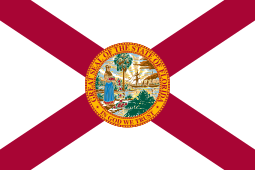| Revision as of 01:23, 5 September 2012 edit199.168.198.88 (talk) Adding references so that Santos can go learn some history. ¡Viva Florida!← Previous edit | Revision as of 02:14, 5 September 2012 edit undoFat&Happy (talk | contribs)Pending changes reviewers42,061 edits grammar & unnecessary redirect; really needs rephrase to avoid links in bolded title restatementNext edit → | ||
| Line 13: | Line 13: | ||
| }} | }} | ||
| The '''] of |
The '''] of ]''' consists of a red ], St. Andrew's Cross, on a white background, with the ] superimposed on the center. The design was approved by a popular referendum in 1900. The current design has been in use since 1985, after the state seal was graphically improved and officially sanctioned for use by state officials. | ||
| ==History== | ==History== | ||
Revision as of 02:14, 5 September 2012
 | |
| Use | Civil and state flag |
|---|---|
| Proportion | 2:3 |
| Adopted | September 24, 1900 |
| Design | Red saltire on a white background, with the seal of Florida superimposed on the center. |
The flag of Florida consists of a red saltire, St. Andrew's Cross, on a white background, with the state seal superimposed on the center. The design was approved by a popular referendum in 1900. The current design has been in use since 1985, after the state seal was graphically improved and officially sanctioned for use by state officials.
History




Spain was a dynastic union and federation of kingdoms when Juan Ponce de León discovered and claimed Florida in 1513. Several flags were used during the first period of Spanish settlement and governance in Florida, such as the standard of the Crown of Castile in Pensacola and the Cross of Burgundy flag in St. Augustine. As with other Spanish territories, the Burgundian saltire was generally used in Florida to represent collective Spanish sovereignty between 1513 and 1821.
In 1763, the Spanish passed control of Florida to Great Britain via the Treaty of Paris. Britain used the original union flag with the white diagonal stripes in Florida during this brief period. The British also divided the Florida territory into East Florida, with its capital at St. Augustine, and West Florida, with its capital at Pensacola.
Spain regained control of Florida in 1783. In 1785, King Charles III chose a new naval and battle flag for Spain, which was now a more centralized nation-state, and its territories. This flag, a tri-band of red-yellow-red, was used along with the Burgundian saltire in the provinces of East and West Florida until 1821, when the Florida provinces joined the United States.
Between 1821 and 1861, Florida had no official flag. The Lone Star and Stripes, previously the Naval Ensign of Texas, was used as a provisional between 1861 and 1868, after Florida seceded from the Union and declared itself a "sovereign and independent nation." This flag was also used when State forces took control of the federal forts and a navy yard in Pensacola. Col. William H. Chase was Commander of Florida Troops and the flag is also referred to as the Chase Flag. Later in the year the Florida Legislature passed a law authorizing Governor Perry to design an official flag for the state. His design was the Stars and Bars but with the blue field extending all the way down the flag and the newly created seal of Florida within the blue field.
As part of the Confederacy, Florida flew all three versions of the Confederate flag and the Bonnie Blue Flag, which was briefly used as an unofficial flag of the Confederacy before the first official flag was adopted. The Bonnie Blue flag had a single five-point star centered in a blue background and was previously used as the flag of the short-lived Republic of West Florida in 1810, which included parts of modern-day Florida, Alabama, Mississippi and Louisiana.
Between 1868 and 1900, the flag of Florida was simply the state seal on a white background. In a discrepancy however, one version of the state seal depicts a steamboat with a white flag that included a red saltire, similar to Florida's current flag. In the late 1890s, Governor Francis P. Fleming, a nationalist, advocated that St. Andrew's Cross be added so that it would not appear to be a white flag of truce hanging still on a flagpole. This addition was approved by popular referendum in 1900. The red saltire of the Cross of Burgundy represents the cross on which St. Andrew was crucified.
Five Flags over Florida
The term "Five Flags over Florida" usually refers to the five governments that have exerted sovereignty over all or part of Florida: the flags of Spain, France, Great Britain, the United States, and the Confederacy. At various times in its history, at least 16 different flags have been used in Florida or parts of Florida.
See also
- State of Florida
- Symbols of the State of Florida
- Great Seal of the State of Florida
- Cross of Burgundy
- Flag of Alabama
References
- "Florida's Historic Flags". Retrieved 2012-08-17.
- "City of Five Flags". Retrieved 2012-09-04.
- "Florida's Historic Flags". Retrieved 2012-09-04.
- "Ordinance of Secession, 1861 (From: Florida Convention of the People, Ordinance of Secession, 1861, Series S972)". Retrieved 2012-08-17.
- ^ "Florida House of Representatives - About Florida – Flags of Florida". Retrieved 2008-11-04.
External links
This Florida-related article is a stub. You can help Misplaced Pages by expanding it. |
This American flag–related article is a stub. You can help Misplaced Pages by expanding it. |